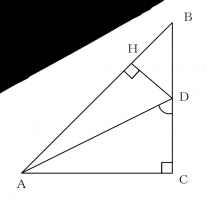Hello everyone. I need help with this problem:

I can't get the right answer for 2). It's √6/2 but I get 3/2.
I did the following for 1)
-to get AD: 1/sin30° = x/sin90°, I got x = 2.
-to get AC: I used the Pythagorean theorem, 1²+x²=2², I got x = √3.
-to get the radius: r = a.b.c/4.area of ADC, r = 1.2.√3/4.(√3/2), I got r = 1. This result is correct.
Then, for 2)
-to get AB: Pythagorean theorem, (√3)²+(√3)²=x², I got x = 3.
-and then, to get the radius of the circumscribed circle of ABC, I wanted to use the same formula as before (r = a.b.c/4.area of ADC), and I did, r = √3.√3.3/4.(√3.√3/2), but I get 3/2 as the result instead of √6/2.
What am I doing wrong? Any help would be much appreciated.
This is the triangle:


I can't get the right answer for 2). It's √6/2 but I get 3/2.
I did the following for 1)
-to get AD: 1/sin30° = x/sin90°, I got x = 2.
-to get AC: I used the Pythagorean theorem, 1²+x²=2², I got x = √3.
-to get the radius: r = a.b.c/4.area of ADC, r = 1.2.√3/4.(√3/2), I got r = 1. This result is correct.
Then, for 2)
-to get AB: Pythagorean theorem, (√3)²+(√3)²=x², I got x = 3.
-and then, to get the radius of the circumscribed circle of ABC, I wanted to use the same formula as before (r = a.b.c/4.area of ADC), and I did, r = √3.√3.3/4.(√3.√3/2), but I get 3/2 as the result instead of √6/2.
What am I doing wrong? Any help would be much appreciated.
This is the triangle:

